Microplastics Found in Womb! For the first time in history, scientists have discovered microplastic particles in a pregnant woman’s placenta that is an organ that develops in the uterus during pregnancy.
It is the first evidence to confirm that artificial particles are found both on the maternal and on fetal part and also found in chorioamniotic membranes. ”
Microplastics Found in Womb- New Study
As we know microplastics usually exist in our daily lives -food, water, and soil. A recent study conducted by the Fatebenefratelli Hospital in Rome and the Polytechnic of the Marche region discovered artificial particles in four women out of six. The study was published in the journal Environment International at the beginning of December. The research was approved by the Ethics Committee and began the research among six healthy women, aged between 18-40 years old who agreed to the examination. Totally, they found 12 microplastic (PM) fragments and the size of microplastic is between 5 and 10 microns. Five of the microplastic particles were detected on the fetal part, four on the maternal part, and three of them on the chorioamniotic membranes.
The researchers analyzed the PM pigment to identify its origin. They discovered that 3 out of 12 fragments were classified as polypropylene, the other nine were synthetic paint materials that were from makeup, face cream, or nail polish. Other possible sources were from air fresheners, scents, adhesives, toothpaste, or plasters.
Antonio Ragusa, director of obstetrics and gynecology at the San Giovanni Calibita Fatebenefratelli hospital in Rome stated “With the presence of plastic in the body, the immune system is disturbed and recognises what is not organic. It is like having a cyborg baby: no longer composed only of human cells, but a mixture of biological and inorganic entities. The mothers were shocked.”
Impact on Women’s Health
What will happen if microplastics found in womb? How microplastics affect their health is still unknown. But scientists stated they could transport synthetic compounds that lead to long-haul impairment or damage the embryo’s forming a safe framework. The examination additionally observed that this microplastic may be swallowed or consumed by the women.
In the research, published in the journal Environment International, the scientists concluded that “Due to the crucial role of placenta in supporting the foetus’s development and in acting as an interface with the external environment, the presence of potentially harmful plastic particles is a matter of great concern. Further studies need to be performed to assess if the presence of microplastics may trigger immune responses or may lead to the release of toxic contaminants, resulting in harm.”
The possible effects of microplastic on women’s health are it can decrease foetal growth. The study researchers further declared that they didn’t find microplastics in two women that may be because of their food habits or lifestyle.
Microplastics pollution is present across the world. Scientists stated it is a severe concern and required to solve the problem, particularly for newborn babies.
They recommended, “Further studies need to be performed to assess if the presence of microplastics may trigger immune responses or may lead to the release of toxic contaminants, resulting in harm.”

















